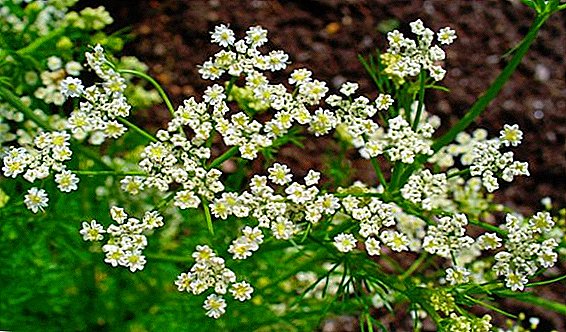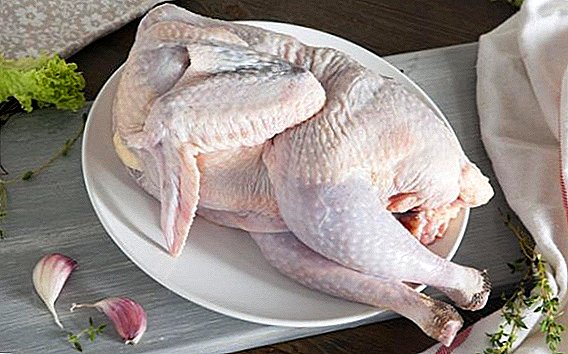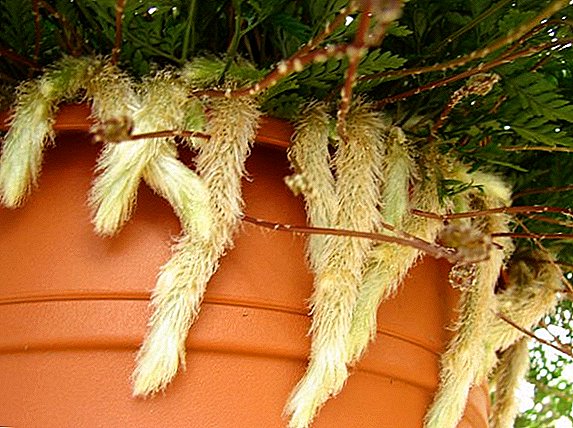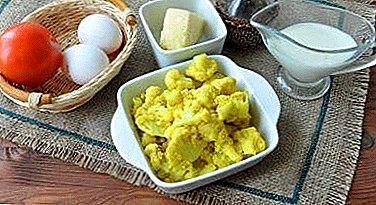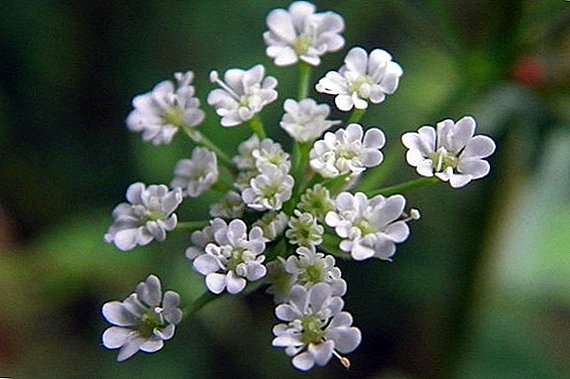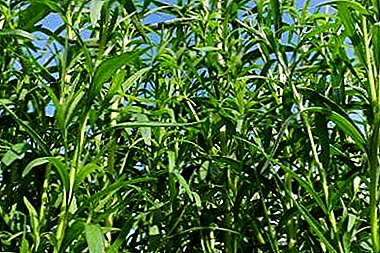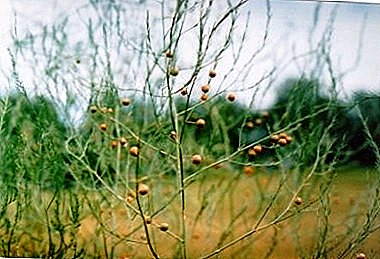
The cultivation of medicinal asparagus is made for both therapeutic and decorative purposes.
This plant is found in the regions of the European part of Russia, in the Caucasus and Kazakhstan.
Description
 Medicinal asparagus is a perennial plant of the Liliana family with healing properties.
Medicinal asparagus is a perennial plant of the Liliana family with healing properties.
It has a strong rhizome and upright stems up to one and a half meters high.
The stems are widely covered with small leaves, in the axils of which so-called cladodia are formed - a collection of filamentous twigs.
Asparagus blooms at the end of spring. Flowering continues until the end of summer.
Asparagus flowers grow in pairs, fastened in the axils of the peduncles. Have a pale greenish color.
Fruits are spherical berries that, when ripe, acquire a red color. Asparagus berries ripen in September.
Look at the photo of Asparagus officinalis below:


Other common species of Asparagus on our website: Sprenger, Sickle, Pisty, Meyer.
Open field maintenance
When growing asparagus requires appropriate care, which is based on moderate watering, regular weeding from the weeds and the constant application of fertilizer.
Growing and breeding
 Dates for growing asparagus are similar to the terms for growing grapes. The period from asparagus planting to harvesting lasts three years.
Dates for growing asparagus are similar to the terms for growing grapes. The period from asparagus planting to harvesting lasts three years.
With the onset of the third year, asparagus begins each year to give young shoots from April to July.
With proper cultivation, this period lasts for 16-20 years.
REFERENCE: A year before planting asparagus at a permanent place of cultivation in a greenhouse or greenhouse, it is necessary to grow seedlings.
Start growing seedlings
Initially, the seeds must be kept in warm water for 3-4 days, as they germinate badly. The seed container can be placed next to the battery to keep the water warm.
Then the seeds are wrapped in wet gauze, folded in several layers and placed inside a small container. Gauze needs to be constantly moistened as moisture evaporates. The seed disclosure process will begin a week later.
TIP: When most seeds are pecked, they must be sorted and stored in a refrigerator before sowing.
Planting and transplanting
 Before planting seedlings need to prepare the beds, providing them with fertilizer.
Before planting seedlings need to prepare the beds, providing them with fertilizer.
Compost or rotted manure is suitable as fertilizer. The soil must be carefully dig and loosen for good air exchange.
Landing is subject to the following conditions:
In early April, the prepared seeds are sown in the grooves made in advance to a depth of 2 centimeters.
The grooves should be located at a distance of 35-45 centimeters, and the distance between the seeds should reach 6-7 centimeters.
TIP: After the seedlings grow up to 3-4 centimeters in height, thinning should be done, leaving stronger plants.
Between shoots it is recommended to maintain a distance of 15 centimeters.
Throughout the summer, weeding must be done, we must be watered regularly and must be fed with fertilizer based on cow manure or fermented hay.
By the end of the summer the plant will develop a rhizome and about 3-4 shoots.
With the arrival of autumn fruits appear. Now you need to pull out the plants with small berries of a rich red color, set them aside for future breeding for decorative purposes. These are female individuals that give weak and tasteless shoots.
 Seedlings can be diluted in pots. Then more powerful and winter-resistant plants will come out.
Seedlings can be diluted in pots. Then more powerful and winter-resistant plants will come out.
Sowing in pots is carried out according to the same parameters as on greenhouse beds.
Sowing time - May. In the pots with seedlings placed and gently distributed manure with sand.
Seeds moderately watered with warm water. Prepared seedlings are planted in the open ground with the arrival of summer time.
Harvesting
Harvest start three years after the construction of asparagus. In the spring is held hilling height of 20-25 centimeters. Shoots begin to cut from May. This can be done daily.
The process of cutting shoots begins with a careful pouring the soil to the base of the shoot. Then the shoot is cut at a distance of 2-4 centimeters from the root, and the hole is buried with soil.
In the first year of harvesting, 5-6 shoots are cut from asparagus in 2-4 weeks; in the second and subsequent years, about 15-25 shoots are cut per plant for 1.5 months.
 Cut off the shoots are washed with cool water, tied in bundles of 500-1000 grams and cleaned in a refrigerator or a fairly cool room.
Cut off the shoots are washed with cool water, tied in bundles of 500-1000 grams and cleaned in a refrigerator or a fairly cool room.
Temperatures up to 1 degree Celsius, humidity up to 90% and no odor are recommended.
So the shoots are stored for up to 3 weeks.
Shoots can not be collected in bunches, and distribute vertically inside the wet river sand.
After the end of the asparagus harvest, the soil is processed. The earth is loosened, saturated with oxygen, watered.
Then complex mineral fertilizers, peat, rotted manure are applied.
Benefit and harm
Asparagus sprouts contain some protein and amino acids, various minerals, vitamins.
The amino acid contained in asparagus asparagine helps to strengthen the kidneys, has a positive effect on heart activity, removes urea from the human body, and also helps to overcome fatigue.
Asparagus is a popular product in the diet. It is used in salads and soups.
Green shoots are healthier than bleached.
Asparagus has a low calorie content. Refers to vegetable crops. To taste has similarities with green peas.
Asparagus is contraindicated in diseases such as rheumatism, various inflammations of the genitourinary system.
Diseases and pests
- Rust;
- Asparagus fly;
- Asparagus ratchet.
 Asparagus Rust caused by a fungus that develops directly on the plant.
Asparagus Rust caused by a fungus that develops directly on the plant.
The disease that appears in the spring does not give out at first, and a little later the stems are covered with oval pads of dirty rusty color, which over time merge together and form volumetric bands.
The diseased plant slows down its development, yielding little yield.
This disease affects plants planted on sandy ground more.
IMPORTANT: At the first sign, it is necessary to remove damaged shoots.
Asparagus fly - an insect with two wings of brown color, reaches a length of 5 mm. Fly activity lasts from April to July.
The fly lays its eggs on asparagus shoots. A week later, the larvae come out, which gnaw the hollow passages inside the stems. As a result, the plant is deformed and yellow.
IMPORTANT: Fight with asparagus flies can only be timely identifying and removing them. When running cases need to transplant asparagus to another place.
Asparagus ratchet - it is a beetle with an orange back and a dark belly, in length reaches 6 mm. Beetles attack asparagus from the beginning of June and live on it until the end of the summer. They gnaw the stems and leaves of the plant. The beetle lays its eggs on the upper parts of the shoots.
The fight is to destroy the remnants of the affected plants.
IMPORTANT: With the large-scale distribution of the pest, asparagus is transplanted to a new place.
Medicinal asparagus can be called a curative medicine and delicacy product that brings a lot of health benefits, but growing it requires tremendous responsibility, hard work and patience.


